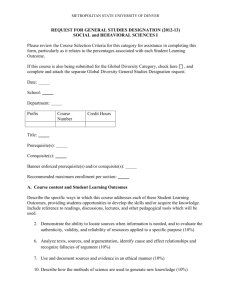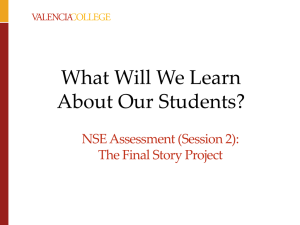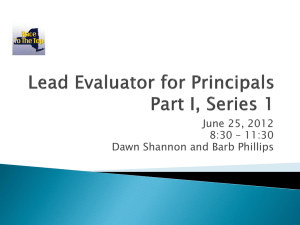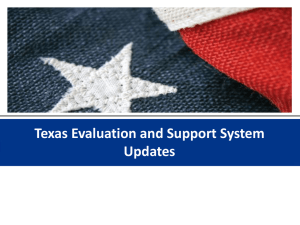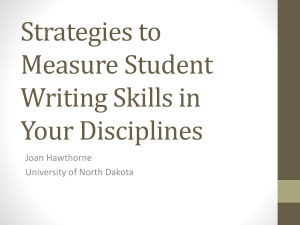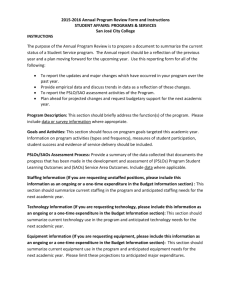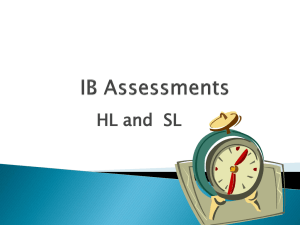Institutional Support Service Area Outcomes
advertisement
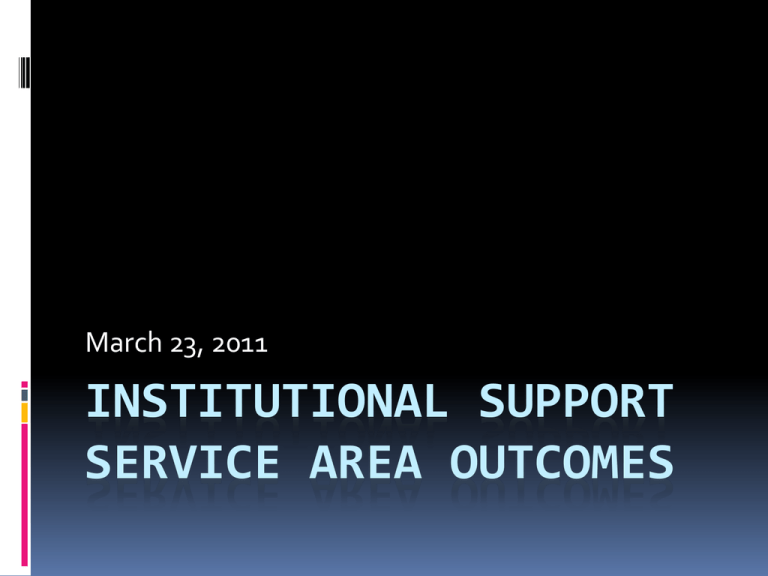
March 23, 2011 INSTITUTIONAL SUPPORT SERVICE AREA OUTCOMES Today’s Outcomes By the end of today’s workshop, participants will be able to . . . Revise and/or finalize SAOs within their areas Discover and articulate commonalities to use for Institutional Support Core Discuss a finalized broad Core and drafted sub-core elements with their staff (if time today) discuss practical assessment tools with their staff Without Outcomes Assessment: When assessment is absent, recurring crisis-management usually takes its place ... episodic events of laborious, broad data-gathering in response to a criticism or mandate … culminating in the usual hastily written (hopefully credible) report that is soon filed and forgotten. ---from Nutshell Notes, The University of Colorado at Denver, v. 4, n. With Outcomes Assessment In contrast, outcomes assessment continuously gathers essential data in ways that address clearly formulated hypotheses. More importantly, this assessment creates a system of routinely utilized knowledge that can be easily built upon. Assessment prevents crises. ---from Nutshell Notes, The University of Colorado at Denver, v. 4, n. What are Outcomes? Goals are what we plan to do or accomplish. Outcomes are what we expect will happen when we do what we planned (what should happen as a result of what we do). Outcomes should ... describe stakeholder behaviors that staff would accept as evidence that the support area is performing its function. Offer who will do what and when (WWW) Outcomes are ... Brief statements of results Describe behaviors of stakeholders Refer to results of processes Used to assess effectiveness and provide improvement information Activity 1 Which is a goal and which is an outcome? Increase student voice in the decision- making model by establishing a student government association. Students will participate more in college-wide committees/councils, task forces, and focus groups. Activity 1 Which is a goal and which is an outcome? Faculty, staff, and students will have access to electronic resources from off-campus locations. Increase access to LRS resources; implement remote user access to electronic resources. Activity 1 Which is a goal and which is an outcome? Office of Research and Planning will provide planning, assessment, and evaluation services to meet the needs of the College. Faculty, administrators, and staff will use information to make decisions or assess the effectiveness of their area. Activity 2 Create an outcome statement that would provide ‘evidence’ that demonstrates achievement of the following goals (remember to state the WWW): Write an outcome statement for the goal: Peace, order, and safety on the campus will be promoted by deterring and preventing criminal activity. Write an outcome statement for the goal: Provide safe, clean, maintained and visually attractive buildings and grounds to be enjoyed by students, faculty, and staff. Write an outcome statement for the goal: Expand outcomes assessment to all areas of the College. Activity 3 Get in small groups to discuss the draft outcomes your areas have created. Does the outcome state what stakeholders should be able to do as a result of what your area does? Does the outcome state the WWW? Is the outcome action-oriented? Would the outcome be clear to someone outside of your area? Is the outcome measureable? Institutional Support Core Outcomes Definition: The collective expression of the results of our individual institutional support service efforts to facilitate student learning. Resources SAOs Core Competencies Strategic Plan Activity 4 What does support service mean in your area? Activity 4 What do we want our institution to be known for in terms of serving our ‘client’ (defined as students, faculty, staff, community)? Assessment INSTITUTIONAL SUPPORT SERVICE AREA OUTCOMES Start with specific criteria and methodology: What data will be used? How will data be gathered? When? Who is responsible? How will data be analyzed? What standard defines success? Example Outcome: Faculty, staff, and students will feel safe when they are on campus. What? Faculty, staff, and student opinions How? Customer Satisfaction Survey When? Annually in the Spring Who? Police Chief and Staff, R&P office How analyzed? Calculate, by group, the percentages of respondent responses Standard of success? 90% report feeling safe Example Outcome: Instructional and non-instructional College units will complete program review and 3-year plans, using data from outcomes assessment, by May of each year. What? Reviews and plans How? Research & Planning tracking system and assessment committee rubric When? Annually by May Who? Deans/Directors as appropriate, R&P, assessment committee How analyzed? Count the number of units who have completed the plans and reviews; evaluate quality based on rubric Standards of success? 100% complete on time, quality outlined in rubric Summarize & Analyze Data What did you find out? Were the criteria met? What problems need addressing? What successes were identified? Create an Action Plan & Implement Changes What changes need to be made? What additional data are needed? What resources are needed? What actions do you plan to take? Who is responsible? Identify & Assess Impact How has your area improved the quality or quantity of what you do as a result of your changes/action plan? Assessment Tips: Keep it simple Focus on essentials you can address Use existing data as much as possible Collect only information you will use Incorporate assessment procedures into routine operations of the area Homework Finalize SAOs Discuss Institutional Support Core with your area (present, brainstorm, revise) Brainstorm possible assessment tools with your area

